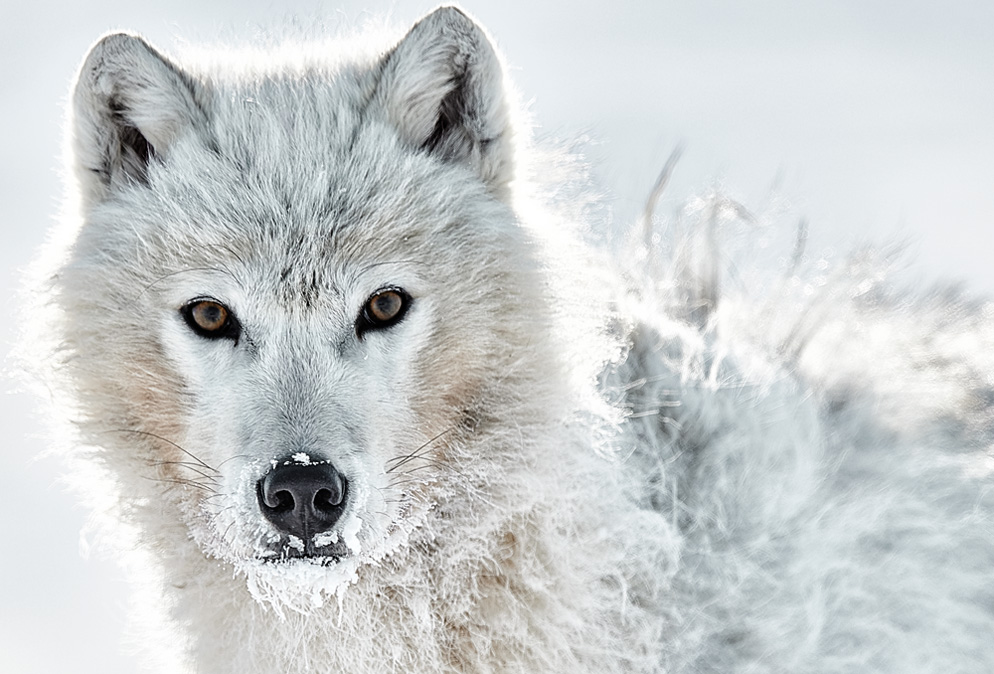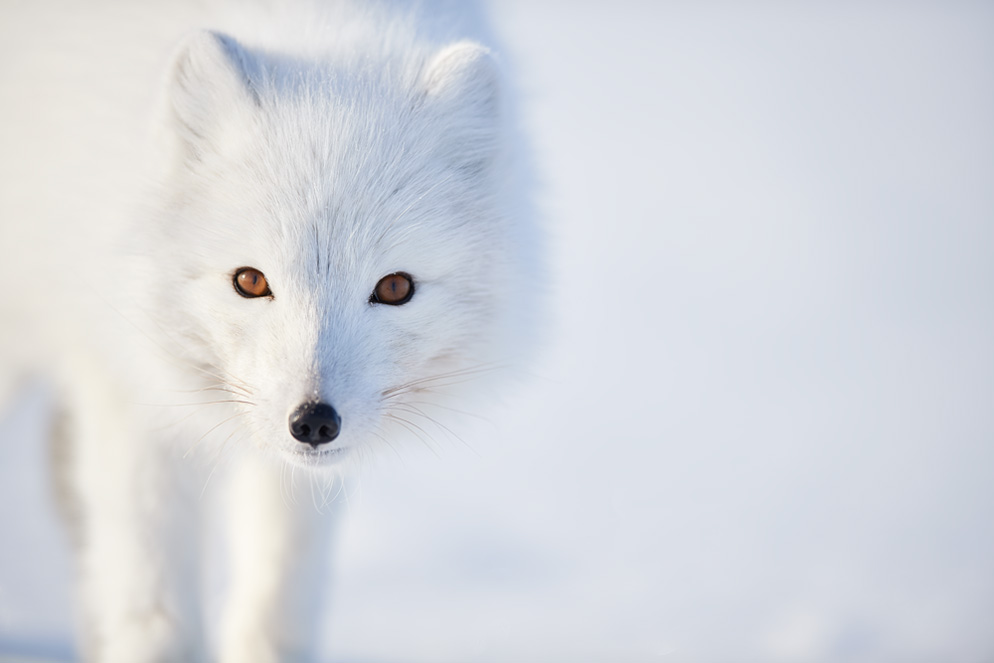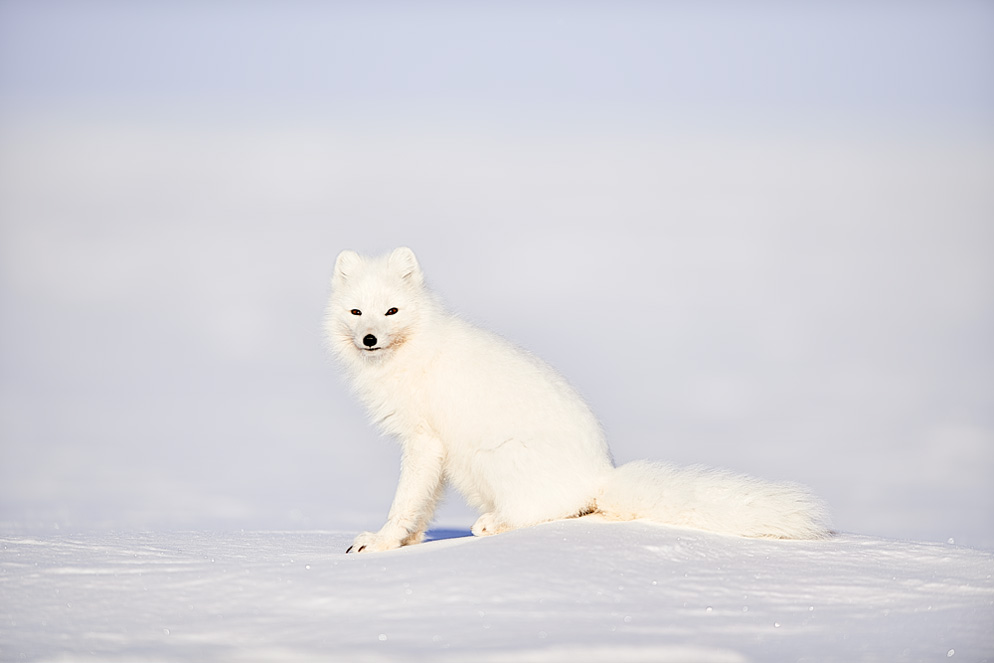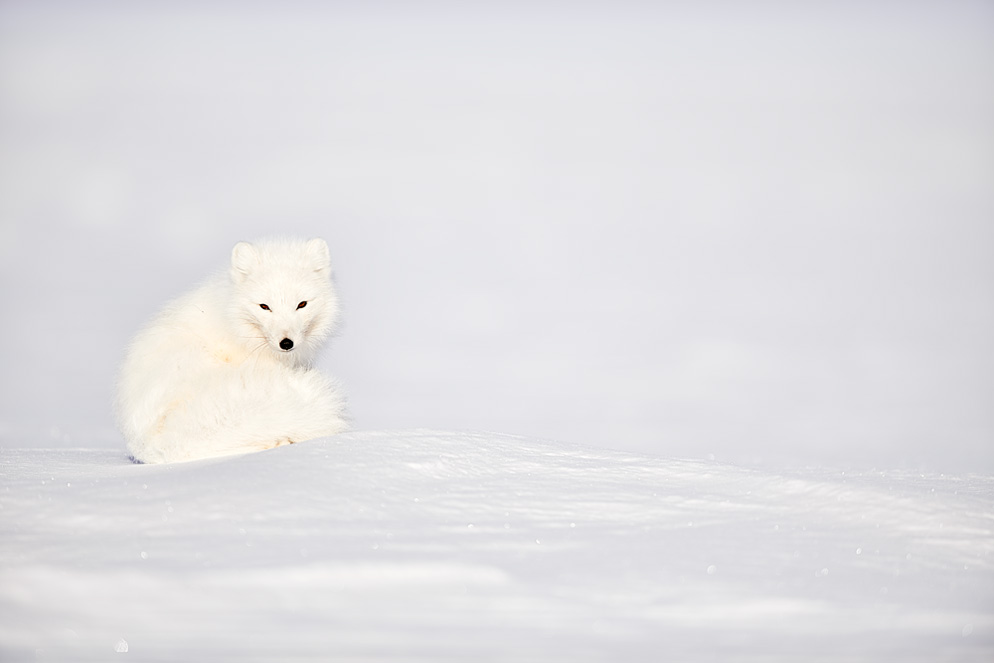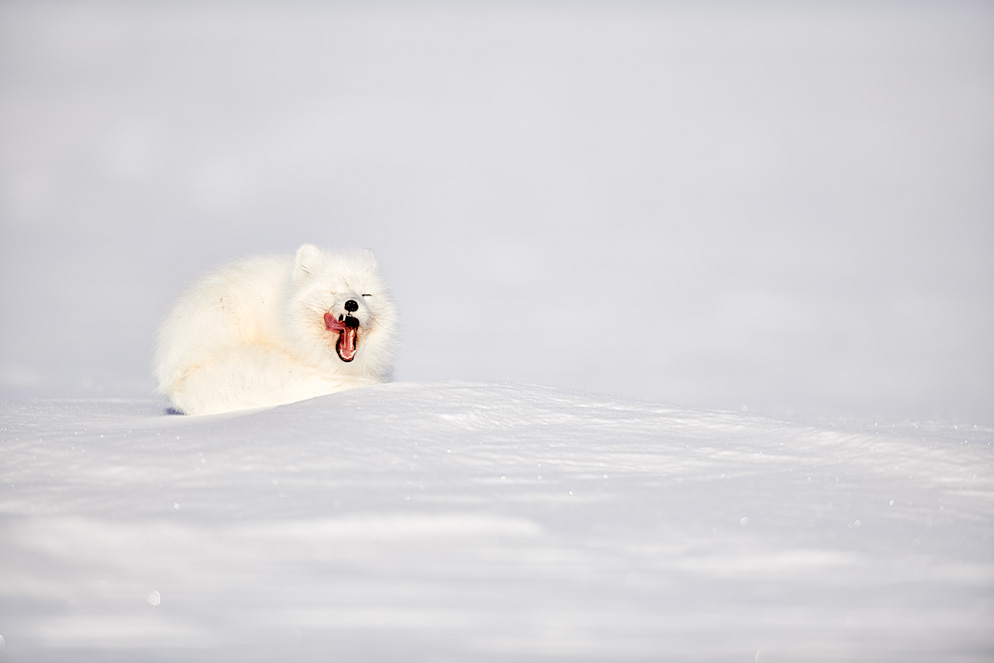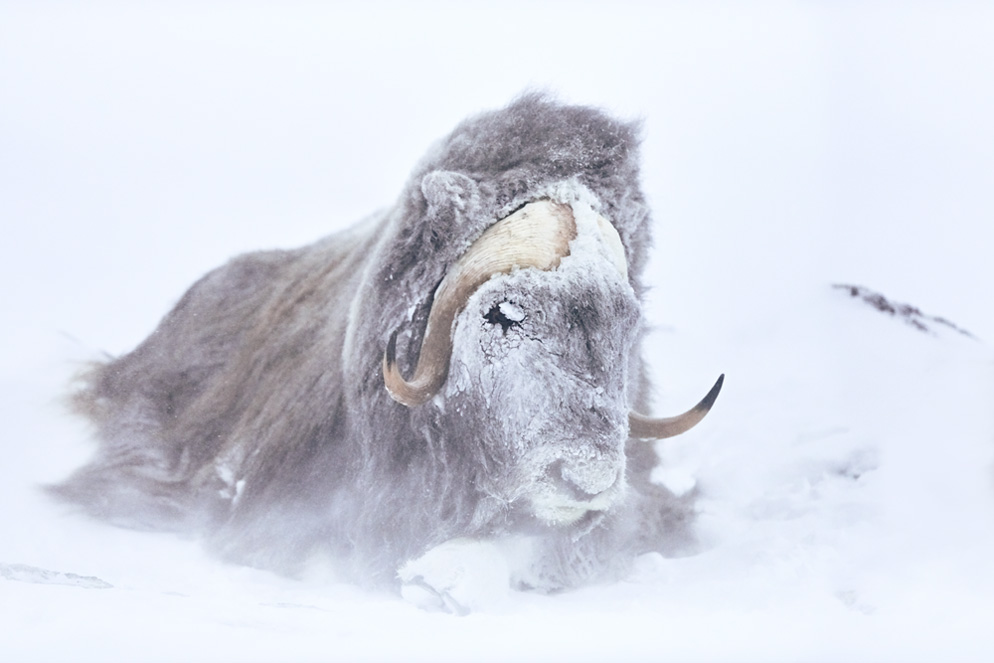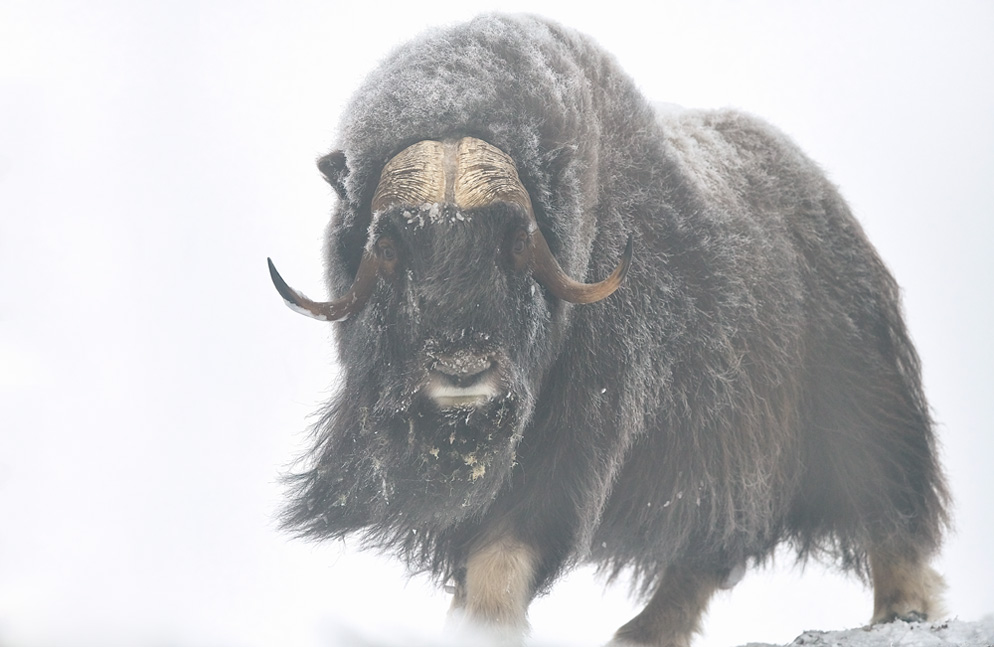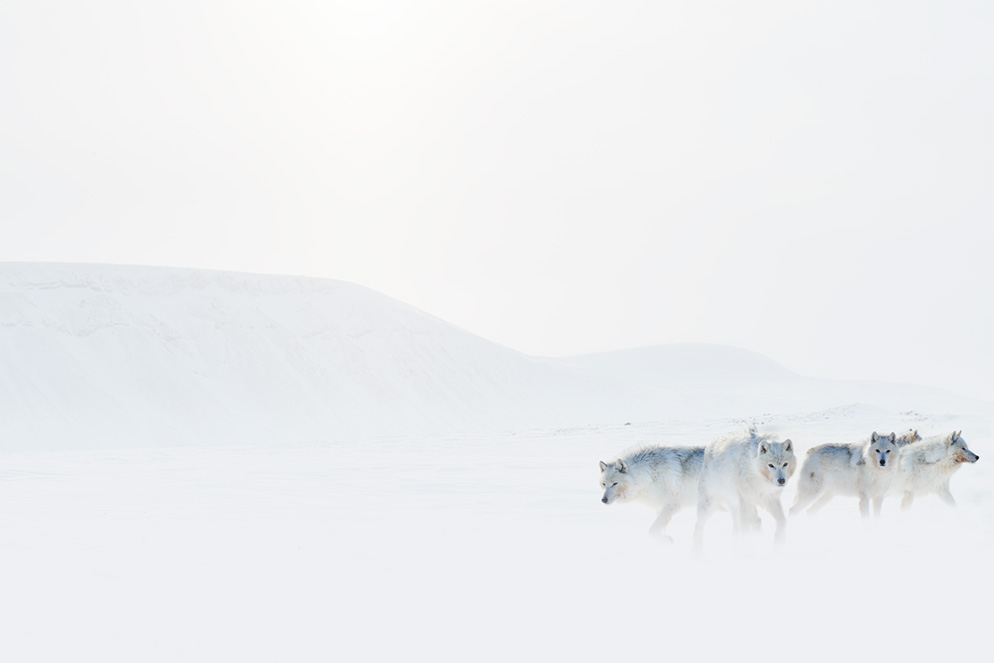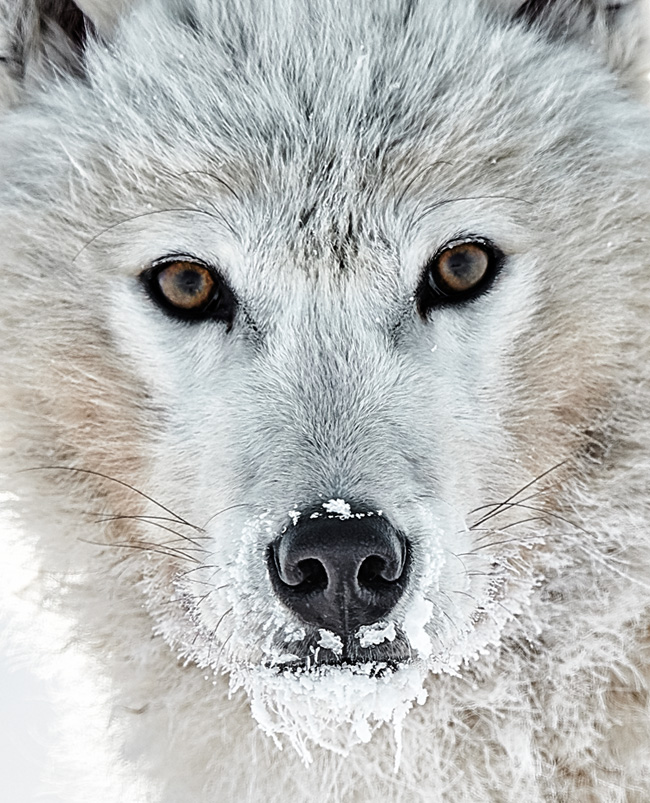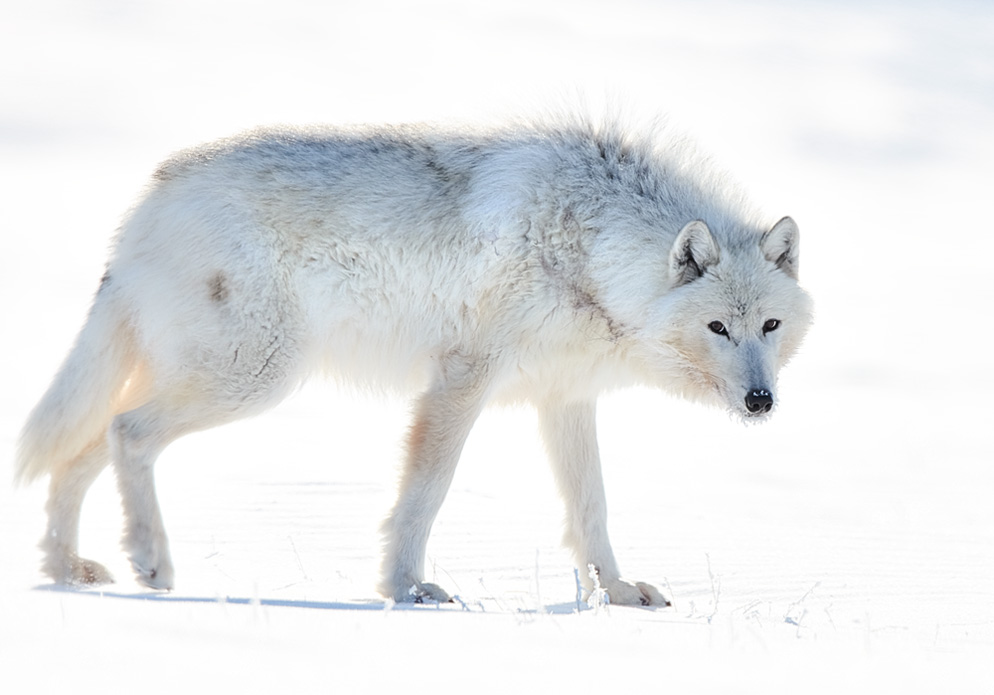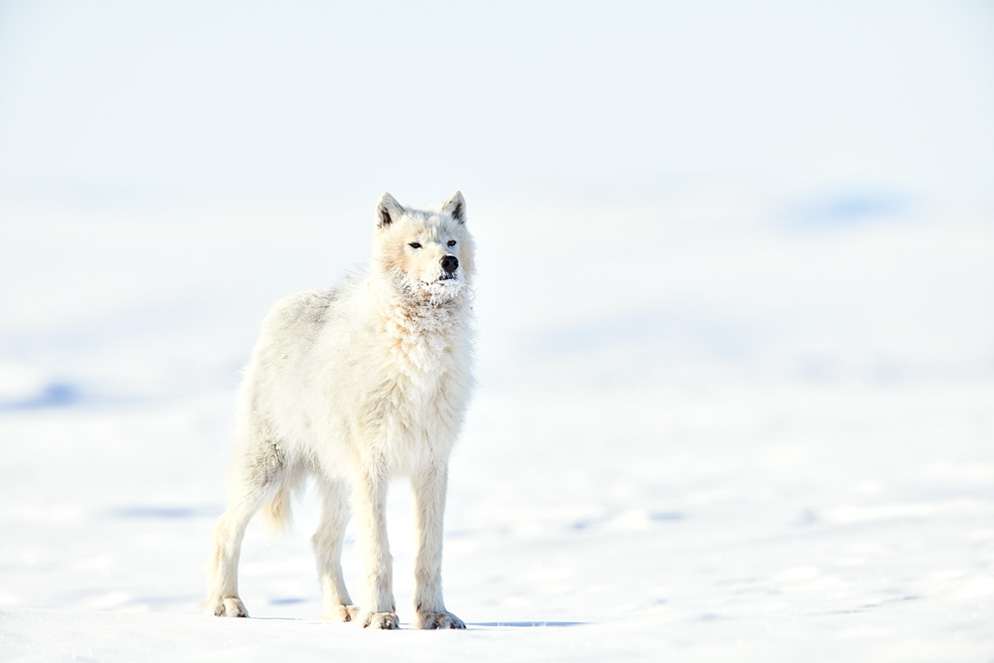Northern Exposure: A Fashion Photographer Pursues Arctic Wolves. What Could Possibly Go Wrong?
The fox wanted to play.
It was the second or third day of Ejaz Khan's Canadian Arctic search for the elusive Arctic wolf—he's actually not sure which day because searching the endless horizon for Arctic wolves "is so boring that time doesn't pass"—when from inside his tent he saw motion outside.
"I don't know what an Arctic wolf looks like, so I thought it was an Arctic wolf," he says, "and I started to tense up. Then I realized it's an Arctic fox."
Well, all right, not the wolf he hoped for, but something to photograph other than vast expanses of white nothing.
But the fox had other ideas.
"He starts to come closer and closer and when he's about 20 feet away from my tent he sits down," Ejaz says. "I photograph him, and of course I got bored taking the same photograph again and again, so I stepped out with my camera and walked toward him—maybe three to ten feet away, and he looked at me like nothing was happening. I thought, Wow, this guy's not scared." So Ejaz walked closer, taking photos all the way, until the fox was too close to focus on. "So like when you play with a dog, you stamp your feet—I did that and he ran away, and I ran behind him...but he stopped and looked at me, and he's once again too close for focus. I moved back to photograph and he ran right back with me—now he's a foot away, and I chased him again and we played this game back and forth for about two hours. I'd back up to shoot, he'd come closer, I'd chase him, start to shoot and he'd come close, and I'd back up again.
"Who knew I'd have a friend up in the Arctic?"
"Done with the game, he relaxes and gives me a big yawn. I was tired, too, and was lying down on the snow about 20 feet away." D5, AF-S NIKKOR 400mm f/2.8G ED VR, 1/1000 second, f/3.2, ISO 100, manual exposure, spot metering.
North to Alaska
Actually, who knew Ejaz Khan would be in the Arctic in the first place?
His photographic career is in fashion photography, and he's had a particularly successful 25-year run at it, shooting for, among others publications, Vogue, Elle and Harper's Bazaar.
But about five years ago he realized he wasn't having a good time anymore. "My fashion work requires a lot of assistants, a lot of lighting, a lot of everything," he says, and budget cuts were cutting into what he enjoyed most and did best.
"I wasn't having fun at work, and I'd always told my kids, if you're having fun, you are never going to work a day in your life."
Then two people close to him—his wife and his producer—conspired to break him out of his funk. "They said, 'Why don't you just go to Alaska? We'll get you a ticket.'” They put him on a plane with cameras he'd never used before—DSLRs rather than the medium format gear he used for his fashion shoots—and he went north to photograph bears.
You can guess what happened.
"On my way back, I called my wife from the airport and said, 'I'm not coming back.' For the first year, it turned into just the selfish need for enjoying nature. Then I started looking into what was going on. There was a pipeline being laid in Alaska, different companies were coming in, and I reached a point where I realized that if we don't protect our environment, future generations won't be able to see what we are seeing."
He's since come to balance his fashion and wildlife photography, and if there's a common denominator to images in both categories it's the narrative drive of his photographs. Ejaz is a storyteller, which is no surprise when you consider his background.
"My father was a film director," he says, "and as a child, along with my brother, I was always on a set. I would listen to what my father was saying and watch what was done. He had 30 people lighting up his sets, and he used to direct them: 'Do this, do that, take that down an inch or two.' I never realized how much of that information really stays in your mind. So when I do [my] theatrical kind of work—big productions, big sets—my dad's always in the back of my mind, always playing a role and guiding me through things."
As an indication of how important wildlife photography is to him now, Ejaz has converted his 3,000-square-foot midtown New York City studio into a gallery for his wildlife images, and he's dedicated a website to his wildlife photography.
Which brings us to the pursuit of the Arctic wolves.
The Arctic wolf pack was scattered when Raymond and Ejaz first saw them. "They were coming closer, but from all directions, like they were having a meeting or something," Ejaz says. "There were eight of them, but the other three were too far away. I thought they'd be afraid, that humans would be their biggest predators, but they seemed to have no fear at all." D5, AF-S NIKKOR 70-200mm f/2.8E FL ED VR, 1/400 second, f/11, ISO 400, manual exposure, spot metering.
Drastic Action
"In the fashion world, most people know me, they know who I am," Ejaz explains. "But in wildlife, if I wanted to do something for the next 20 years, I needed to take some drastic action."
For recognition, and the spotlight, it was a straightforward solution: do something—photograph something—in a dramatic way.
"I am always looking for drama," he says. "I wanted the Arctic wolf, and I knew it wasn't going to be easy. I know of a photographer who's gone up there for nine years and come back with nothing, and when I heard that story I said, 'Okay, that's it, I'm going.' I didn't expect to come back with photographs the first time [but] I enjoy a challenge, and I said, 'Why don't I start at the top?' "
Well, there were several reasons, starting with "completely out of his element," but if he'd considered them carefully we wouldn't have a story.
You could start listing those reasons with simply getting there: New York to Ottawa, Ottawa to Iqaluit, then on to Resolute Bay, then to Grise Fjord. Along the way there were -25 degree temperatures, constant 25-30 mile-per-hour winds, no cell phone—"coming from New York, I live on the phone"—and a meeting at Resolute Bay with members of the Canadian military who told him that he should have a crew with him for a journey like this and the whole thing was "a stupid move."
"The alpha female of the pack, checking me out." D850, AF-S NIKKOR 400mm f/2.8G ED VR, AF-S Teleconverter TC-14E II, 1/1600 second, f/5, ISO 320, manual exposure, spot metering.
At that point, he was inclined to agree. And that was before he met up with Raymond, his Inuit guide, at Grise Fiord.
"In this town there are 131 people, so he was used to not talking very much—or at all," Ejaz says, "and here I'm coming from New York and I need to talk to someone every minute. So I kept on talking, and he was very quiet. And then we got onto the snowmobile and rode for about eight hours."
And it wasn't one of those smooth glides over the flat lands and through the beautiful landscapes of a snowmobile commercial. "There were no roads, no paths—it was a rough ride, bouncing all the time."
When they finally arrived at their destination there's nothing but ice, snow, emptiness and no communication with the rest of the world. "I should have taken at least a satellite phone with me," Ejaz says.
But he had three things going for him: he might have been rattled, even panicked at times, but he was determined to succeed. Second, Raymond may have been silent, but he was experienced. And third, despite temperatures that reached -50, Ejaz could rely on his cameras—a D5 and a D850—for uninterrupted performance.
"Another shot of the alpha female—she walked closer to me and I stood my ground. I felt privileged to be this close to her." D850, AF-S NIKKOR 400mm f/2.8G ED VR, AF-S Teleconverter TC-14E II, 1/1600 second, f/5, ISO 320, manual exposure, spot metering.
... despite temperatures that reached -50, Ejaz could rely on his cameras—a D5 and a D850—for uninterrupted performance.
He had recently switched to Nikon from a different DSLR brand. He had several reasons: the D5's high-speed frame rate—12 frames per second—and its focusing speed and accuracy; and the D850's megapixel count.
"The D5 is an amazing camera for action and speed. I love to have drama in my photos, and I was once photographing horses that were running at 30 miles an hour, and not just running—they're fighting with each other and turning in different directions, and I was able to get it because of the quickness of that camera."
The D850 was important because of its resolution. "I knew I'd be selling up to 4x6-foot prints of my wildlife images, and I needed incredible detail." And Ejaz's D850 has found a home in the studio as well. "I used to shoot my fashion work with [medium-format] cameras—if you don't shoot medium format, the fashion people think you're not as good a photographer—but I just finished a fashion/beauty shoot with the D850, and it was great."
In the cold of the Canadian Arctic, he shot video and stills with the D850, but when the fox showed up, his choice was the D5. "I thought the fox would be unpredictable and give me a little more action."
He was half right: the playful nature of the fox was something he certainly couldn't predict.
"The alpha male—wherever he's going, he's not taking his eyes off me. All through the encounter, he kept looking at me." D850, AF-S NIKKOR 400mm f/2.8G ED VR, AF-S Teleconverter TC-14E II, 1/1600 second, f/6.3, ISO 320, manual exposure, spot metering.
On the Way Home
After six days, with the Arctic fox the only photo op, Ejaz was ready to bail.
"I just didn't have it in me anymore," he says. "There's no night because the sun never goes down, and sitting in the tent constantly was making me crazy. It was so cold up there, all the plastic zippers and plastic handles became so brittle they'd broken, even the zippers on my jacket. We were supposed to leave a day later but on the seventh day I thought, That's enough. Guys have come here year after year and seen no wolves, so who was I to think I could do this?"
So he packed up. "When I pack for travel I don't keep the lenses on the cameras—and especially not this time with all the bouncing around of the snowmobile."
An hour into the ride back, Ejaz, sitting behind Raymond and unable to see ahead, sensed the snowmobile slowing down. "I said, 'Why are we slowing?' He said nothing. Then we stopped. I couldn't see around him, but I saw he was smiling. Now, to get a smile out of him was impossible, so I knew what it was: he saw the wolves, and when I looked, I saw them in the distance, walking toward us.
"I have no clue how I put my camera and lens together and got them on the tripod so quickly, but I had them ready in ten or 15 seconds."
The wolves came toward the snowmobile. "They came within maybe 20 feet. I took photographs, and then they moved on past us. By that time I had the second camera ready, and I started to walk toward them, photographing. When I was ten feet away, the hair on the alpha male's neck stood up as he looked at me. It was a challenge: Please don't come a step closer. Raymond said, 'It's going to be him or you.' That's when we left."
Raymond is a man of few words, but Ejaz is pretty sure that back home he told a story of his own—a story about a crazy guy from New York who came north to find and photograph Arctic wolves, and pretty much against all odds, got to do just that.
"I think this one was the second or third ranking of the pack. He seemed to be a guard. He was, I think, sniffing. Before they reached me, he had his nose up and I saw movement on his face, so I think he was taking in the air and trying to figure out what I was. They're not used to humans, and because over my Patagonia pants I was wearing polar bear pants, he might have been confused by the different smells." D850, AF-S NIKKOR 400mm f/2.8G ED VR, AF-S Teleconverter TC-14E II, 1/1600 second, f/6.3, ISO 320, manual exposure, spot metering.

